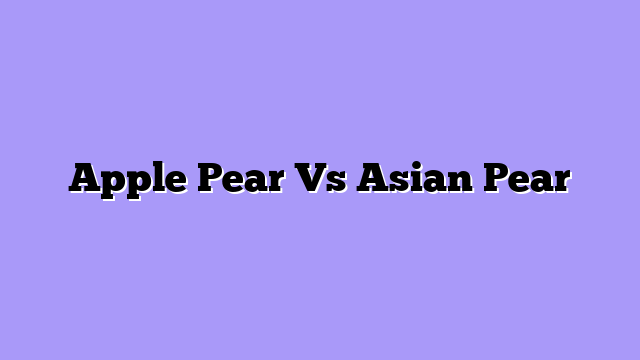Apple pears and Asian pears are both delicious fruits, but they have distinct differences in taste, texture, and appearance. Apple pears, native to Europe, have a sweet and slightly tart flavor with a juicy, crisp texture. Asian pears, originating in Asia, are known for their crisp, refreshing taste and a firm, almost crunchy texture.
Taste and Texture Differences
The terms “apple pear” and “Asian pear” are often used interchangeably, leading to confusion among consumers. While both belong to the same botanical family, *Pyrus*, they represent distinct species with unique characteristics. Understanding these differences is crucial for making informed choices when selecting pears for consumption.
Apple pears, scientifically known as *Pyrus communis*, are the most common type found in Western markets. They are characterized by their crisp, juicy texture and sweet, slightly tart flavor. The flesh of apple pears is typically white or cream-colored, and the skin can range from green to red depending on the variety. Popular examples include the Anjou, Bosc, and Bartlett pears.
Asian pears, on the other hand, belong to the *Pyrus pyrifolia* species and are native to East Asia. They are often referred to as “sand pears” due to their distinctive gritty texture. This texture arises from the presence of stone cells, which are small, hard cells that contribute to a crunchy, almost grainy mouthfeel. Asian pears are generally sweeter than apple pears, with a flavor profile that can range from mild to intensely sweet. Some varieties, like the Hosui, exhibit a subtle floral aroma.

The choice between apple and Asian pears ultimately depends on personal preference. If you enjoy a crisp, juicy pear with a sweet and slightly tart flavor, then apple pears are a good choice. However, if you prefer a crunchy, grainy texture and a sweeter flavor profile, then Asian pears are the better option.
Beyond taste and texture, apple and Asian pears also differ in their culinary applications. Apple pears are commonly used in salads, desserts, and baked goods. Their juicy texture and sweet flavor make them a versatile ingredient. Asian pears, on the other hand, are often enjoyed fresh, as their gritty texture can be challenging to incorporate into cooked dishes. They are also a popular ingredient in Asian cuisine, where their sweetness and crunchy texture complement savory dishes.
In conclusion, while both apple and Asian pears are delicious fruits, they offer distinct taste and texture experiences. Understanding these differences allows consumers to make informed choices based on their individual preferences and culinary needs. Whether you prefer the crisp, juicy sweetness of an apple pear or the crunchy, grainy sweetness of an Asian pear, there is a pear variety to satisfy every palate.
Nutritional Value Comparison
Apple pears, typically characterized by their juicy, sweet, and slightly tart flavor, are rich in vitamin C, an essential antioxidant that supports immune function and collagen production. They also contain a good amount of potassium, a mineral crucial for maintaining healthy blood pressure and muscle function. Furthermore, apple pears are a good source of dietary fiber, which aids in digestion and promotes satiety.
Asian pears, on the other hand, are known for their crisp texture and refreshing, slightly sweet flavor. They are particularly rich in vitamin K, a nutrient vital for blood clotting and bone health. Additionally, Asian pears are a good source of folate, a B vitamin essential for cell growth and development. They also contain a significant amount of copper, a mineral that plays a role in energy production and iron absorption.
In terms of their nutritional value, both apple and Asian pears offer a range of health benefits. Apple pears, with their higher vitamin C content, are particularly beneficial for boosting immunity and promoting skin health. Asian pears, with their abundance of vitamin K and folate, are crucial for blood clotting, bone health, and cell growth.
However, it’s important to note that the specific nutrient content of both types of pears can vary depending on factors such as variety, growing conditions, and ripeness. Nevertheless, both apple and Asian pears are low in calories and fat, making them a healthy and satisfying snack or addition to meals.
Ultimately, the choice between apple and Asian pears comes down to personal preference. While both offer a range of nutritional benefits, their distinct flavor profiles and nutrient compositions cater to different dietary needs and preferences. Whether you enjoy the juicy sweetness of an apple pear or the crisp, refreshing taste of an Asian pear, both fruits are valuable additions to a healthy and balanced diet.
Culinary Uses and Recipes
The world of pears offers a delightful array of flavors and textures, each variety possessing unique characteristics that lend themselves to specific culinary applications. Among the most popular and distinct types are the apple pear and the Asian pear. While both share the common pear shape and juicy flesh, their differences in taste, texture, and culinary uses set them apart.
Apple pears, also known as European pears, are characterized by their sweet and slightly tart flavor, reminiscent of apples, hence their name. Their flesh is typically firm and juicy, with a melting texture when ripe. This combination of sweetness and firmness makes apple pears ideal for baking, poaching, and grilling. Their ability to hold their shape well during cooking makes them a popular choice for pies, tarts, and crumbles. Their juicy nature also lends itself to sauces and compotes, adding a delightful sweetness and depth of flavor to savory dishes.

When it comes to recipes, the culinary versatility of both apple and Asian pears shines through. For apple pears, a classic pear tart is a timeless favorite. The sweet and tart flavor of the pears, combined with a buttery crust, creates a delightful balance of flavors and textures. Another popular option is poached pears, where the pears are gently simmered in a flavorful syrup, resulting in a tender and succulent treat. For a more savory application, apple pears can be grilled and served with a tangy balsamic glaze, adding a touch of sweetness and complexity to the dish.
Asian pears, with their crispness and refreshing flavor, are perfect for salads. A simple salad of Asian pears, mixed greens, and a light vinaigrette is a refreshing and healthy option. Their firm texture also makes them ideal for stir-fries, where they add a delightful crunch and a touch of sweetness to the dish. For a unique and flavorful appetizer, Asian pears can be thinly sliced and served with a creamy goat cheese spread, creating a delightful contrast of textures and flavors.
In conclusion, both apple and Asian pears offer a unique culinary experience, each with its own distinct characteristics and applications. Apple pears, with their sweet and tart flavor and firm texture, are perfect for baking, poaching, and grilling, while Asian pears, with their crisp and refreshing taste and firm texture, are ideal for eating raw, adding a delightful crunch to salads and other dishes. Whether you prefer the classic sweetness of an apple pear or the refreshing crunch of an Asian pear, both varieties offer a delightful addition to any culinary repertoire.
Growing and Harvesting Considerations
The distinction between apple pears and Asian pears, while seemingly straightforward, can be a source of confusion for both novice and seasoned gardeners. Both types of pears belong to the same genus, *Pyrus*, but their origins and growing habits differ significantly. Understanding these differences is crucial for successful cultivation and harvesting.
Apple pears, also known as European pears, are native to Europe and Western Asia. They are characterized by their crisp, juicy flesh and sweet, slightly tart flavor. These pears typically require a long growing season and thrive in temperate climates with cool winters and warm summers. They are also known for their susceptibility to various diseases and pests, necessitating careful monitoring and preventative measures.
Asian pears, on the other hand, hail from East Asia and are renowned for their firm, crunchy texture and refreshing, slightly sweet flavor. They are generally more cold-hardy than apple pears and can tolerate a wider range of growing conditions. However, Asian pears are more susceptible to fire blight, a bacterial disease that can severely damage the trees.
When considering growing conditions, both types of pears require well-drained soil with a pH between 6.0 and 7.0. They also benefit from full sun exposure, receiving at least six hours of direct sunlight daily. However, apple pears prefer slightly acidic soil, while Asian pears tolerate a wider range of soil pH levels.
The timing of planting is another crucial factor. Apple pears are typically planted in the fall or early spring, while Asian pears can be planted in the spring or early summer. This difference is attributed to their varying cold hardiness levels.
Harvesting time is determined by the pear variety and the desired level of ripeness. Apple pears are typically harvested in late summer or early fall, while Asian pears are harvested in late fall or early winter. The optimal time for harvesting is when the pears have reached their full size and have a slight give when gently pressed.
Once harvested, both types of pears can be stored at room temperature for a few days or refrigerated for several weeks. However, Asian pears tend to have a longer shelf life than apple pears.
In conclusion, while both apple pears and Asian pears offer unique flavors and textures, their growing and harvesting considerations differ significantly. Understanding these differences is essential for successful cultivation and enjoyment of these delicious fruits. By carefully selecting the appropriate variety, providing optimal growing conditions, and harvesting at the right time, gardeners can ensure a bountiful harvest of both types of pears.
Q&A
## 5 Questions and Answers about Apple Pear vs Asian Pear:
**1. What is the main difference between an apple pear and an Asian pear?**
**Answer:** Apple pears are European pears with a sweet, juicy, and slightly grainy texture. Asian pears are crisp, firm, and have a refreshing, slightly sweet flavor.
**2. What is the texture of an apple pear?**
**Answer:** Apple pears have a soft, juicy, and slightly grainy texture.
**3. What is the texture of an Asian pear?**
**Answer:** Asian pears have a crisp, firm, and crunchy texture.
**4. What is the flavor of an apple pear?**
**Answer:** Apple pears have a sweet, juicy, and slightly tart flavor.
**5. What is the flavor of an Asian pear?**
**Answer:** Asian pears have a refreshing, slightly sweet, and sometimes slightly tangy flavor.Apple pears and Asian pears offer distinct flavor profiles and textures. Apple pears are crisp and juicy with a sweet and slightly tart flavor, while Asian pears are crunchy and firm with a refreshing, slightly sweet flavor. Ultimately, the best pear for you depends on your personal preference.








